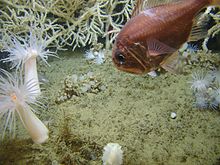Saw bellies
| Saw bellies | ||||||||||||
|---|---|---|---|---|---|---|---|---|---|---|---|---|

Optivus elongatus |
||||||||||||
| Systematics | ||||||||||||
|
||||||||||||
| Scientific name | ||||||||||||
| Trachichthyidae | ||||||||||||
| Bleeker , 1859 |
The saw bellies (Trachichthyidae) ( Gr .: trachys = rough, ichthys = fish) live in the deep sea in temperate to tropical regions of the Atlantic and Indo-Pacific . They are called saw bellies because of their spiky scales on the ventral side.
Appearance
Saw bellies have a high-backed, laterally compressed body, large heads. The sideline continues in the form of slime-filled grooves on the skull. The species of the genera Optivus , Paratrachichthys and Sorosichthys differ from other members of the family by their elongated body.
The (only) dorsal fin has 3 to 8 hard rays and 10 to 19 soft rays, the anal fin has 2 to 3 hard rays and 8 to 12 soft rays. The pelvic fins are also supported by a hard beam. Saw bellies have ctenoid scales . The sideline is protected by enlarged scales.
Living saw bellies are light red with fins of the same color, silver or dark gray to black with transparent fins. Some species e.g. B. Aulotrachichthys latus can produce bioluminescent light with the help of symbiotic bacteria .
The largest species is Hoplostethus atlanticus with a maximum length of 75 centimeters and a weight of 7 kilograms, but most of the saw bellies remain below 30 centimeters.
behavior
Most saw bellies are sluggish animals and spend most of their time near the continental slopes at depths of about 100 to 1,500 meters with usually rocky surfaces. The leaner species are more active and live in flatter regions. Optivuse longatus lives in shallower coastal waters, but is nocturnal and hides in crevices during the day. The high-backed Trachichthys australis lives in the same habitat and resembles a soldier fish.
Saw bellies live on zooplankton like small crustaceans and fish larvae. If they do not find enough food, the metabolism changes, they live on reserves and lose pigmentation. Some species sporadically form dense schools around geological structures such as submarine ravines and mountains. Perhaps there is a higher density of their prey there due to currents.
Reproduction
Saw bellies do not become sexually mature and spawn pelagic until the age of 18 ; they gather in groups and release sperm and egg cells into the open water. The fertilized eggs and later the larvae are planktonic . In the economically important species, the larvae of Gephyroberyx darwinii live in shallow water, while those of Hoplostethus atlanticus live in deeper water of around 200 meters.
Saw bellies are very durable and also grow slowly. A Hoplostethus atlanticus is said to be 149 years old.
Systematics
The family contains 48 species in eight genera .
- Genus Aulotrachichthys Fowler, 1938
- Aulotrachichthys latus (Fowler, 1938) .
- Genus Gephyroberyx Boulenger, 1902
- Gephyroberyx darwinii (Johnson, 1866) .
- Gephyroberyx japonicus (Hilgendorf, 1879) .
- Gephyroberyx philippinus Fowler, 1938 .
- Genus Hoplostethus Cuvier in Cuvier & Valenciennes, 1829
- Hoplostethus abramovi Kotlyar, 1986 .
- Hoplostethus atlanticus Collett, 1889 .
- Hoplostethus cadenati Quéro, 1974 .
- Hoplostethus confinis Kotlyar, 1980 .
- Hoplostethus crassispinus Kotlyar, 1980 .
- Hoplostethus druzhinini Kotlyar, 1986 .
- Hoplostethus fedorovi Kotlyar, 1986 .
- Hoplostethus fragilis (de Buen, 1959) .
- Hoplostethus gigas McCulloch, 1914 .
- Hoplostethus grandperrini Roberts & Gomon, 2012 .
- Hoplostethus intermedius (Hector, 1875) .
- Hoplostethus japonicus Hilgendorf, 1879 .
- Hoplostethus latus (Fowler, 1938) .
- Hoplostethus marisrubri Kotlyar, 1986 .
- Hoplostethus mediterraneus Cuvier in Cuvier & Valenciennes, 1829
- Hoplostethus melanopeza Roberts & Gomon, 2012 .
- Hoplostethus melanopterus Fowler, 1938 .
- Hoplostethus melanopus (Weber, 1913) .
- Hoplostethus mento ( Garman , 1899) .
- Hoplostethus metallicus Fowler, 1938 .
- Hoplostethus mikhailini Kotlyar, 1986 .
- Hoplostethus occidentalis Woods, 1973 .
- Hoplostethus pacificus Garman , 1899 .
- Hoplostethus rifti Kotlyar, 1986 .
- Hoplostethus rubellopterus Kotlyar, 1980 .
- Hoplostethus shubnikovi Kotlyar, 1980 .
- Hoplostethus tenebricus Kotlyar, 1980 .
- Hoplostethus vniro Kotlyar, 1995 .
- Genus Optivus Whitley, 1947
- Optivus elongatus ( Günther , 1859) .
- Genus Paratrachichthys Waite, 1899
- Paratrachichthys argyrophanus Woods, 1961 .
- Paratrachichthys atlanticus (Collett, 1889) .
- Paratrachichthys fernandezianus ( Günther , 1887) .
- Paratrachichthys heptalepis Gon, 1984 .
- Paratrachichthys novaezelandicus Kotlyar, 1980 .
- Paratrachichthys prosthemius Jordan & Fowler, 1902 .
- Paratrachichthys pulsator (Gomon & Kuiter, 1987) .
- Paratrachichthys sajademalensis Kotlyar, 1979 .
- Paratrachichthys trailli (Hutton, 1875) .
- Genus Parinoberyx Kotlyar, 1984
- Parinoberyx horridus Kotlyar, 1984 .
- Genus Sorosichthys Whitley, 1945
- Sorosichthys ananassa Whitley, 1945 .
- Genus Trachichthys Shaw in Shaw & Nodder, 1799
- Trachichthys australis Shaw, 1799 .
fishing
The larger species Hoplostethus atlanticus and Gephyroberyx darwinii are fished commercially in the seas around Australia and New Zealand. Hoplostethus atlanticus is an edible fish and is sold as fresh fish or frozen emperor perch. Gephyroberyx darwinii is processed into fish meal. Since the animals reproduce slowly, the stocks are considered endangered.
literature
- Joseph S. Nelson, Terry C. Grande, Mark VH Wilson: Fishes of the World. Wiley, Hoboken, New Jersey 2016, ISBN 978-1118342336 .
Web links
- Saw bellies on Fishbase.org (English)




